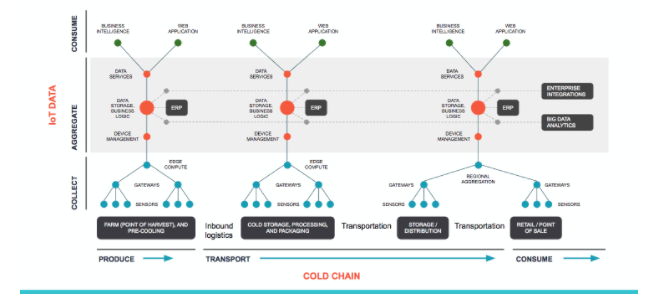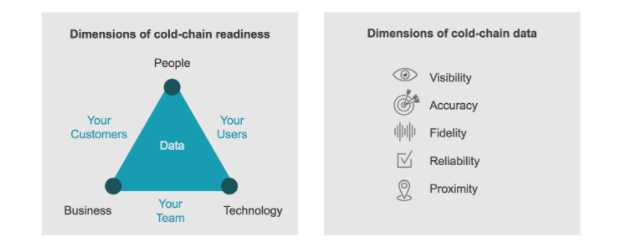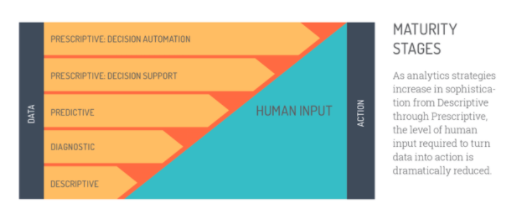Holistic Cold-Chain Management
by Exosite, on February 8, 2018
Moving Towards Holistic Cold-Chain Management
The cold chain of the future is much more than the simple monitoring of temperature and humidity of goods. Rather than looking only at the goods themselves, it also monitors the health of the equipment, vehicles, fuel, labor, time, and maintenance history that surrounds and supports the cold chain and makes it possible. Without this, true cold-chain integrity is impossible. This is true not only for food and pharmaceuticals, where regulatory compliance is mandatory, but also for medical supplies, biological products, and chemicals. Companies that are able to manage cold-chain elements more efficiently will rise to the top as market leaders with better margins and more ecosystem leverage.
In this blog, we'll discuss the general benefits of holistic cold-chain monitoring, the process and resulting challenges of implementation, and the varying levels of solution maturity. Finally, we'll provide a brief overview of the cold-chain solutions Exosite and ARM have teamed up to provide to enable customers to get started quickly.
Benefits of Holistic Cold-Chain Remote Monitoring
The four main benefits of this type of holistic cold-chain remote monitoring are:
- Reduced equipment downtime. With the addition of smart sensing equipment, it becomes possible to have foreknowledge of potential future issues before they occur. By catching issues early, unplanned downtime and maintenance can be reduced.
- Predictive maintenance and repair. Streamlined operations, driven by efficient delivery routes, reduction of paperwork and reduced vehicle maintenance and fuel consumption.
- Streamlined processes and workflows. Increased visibility of all aspects of their business, including driver behavior, activities and safety/security.
- Stronger ecosystem relationships. Stronger customer relationships and satisfaction, leading to more on-time deliveries and the ability to make informed business decisions.
The result? A cold chain that is better equipped to maintain the safety and integrity of the goods that pass through it at lower risk, as well as more efficient and streamlined operations.
Implementing a Holistic Data-Driven Cold Chain
A traditional cold chain for food products includes many steps. As you can see along the bottom of the diagram below, food is first produced, harvested, and pre-cooled. Inbound logistics transport produce to cold-storage facilities where the food is processed and packaged. From there, food products are transported to distribution or storage facilities. Finally, those products are then transported to the point of sale where they are purchased and consumed.

The foundational elements of a healthy cold-chain are based on temperature and humidity sensors that are placed throughout the cold chain, as well as contractual relationships with companies that participate in order to provide accountability and integrity for the entire system.
Companies that participate in the cold-chain ecosystem can further differentiate themselves by increasing the level of visibility into operations and asset health and by integrating data with other members of the cold-chain ecosystem.
To do that, you must look at the cold-chain ecosystem as a series of discrete IoT data silos, each of which provide insight into a particular set of assets of a piece of the process. By adding smart sensors to cold-chain equipment, there is significant opportunity to then integrate these IoT data silos together to provide a holistic view of the health, integrity, and safety of the entire process of transporting goods from farm to fork.
Why is it so Difficult?
Cold-chain systems are a complex balance of business, technology, and people needs, and those three legs of the stool must stand together in order for a cold-chain project to be successful long term for customers and users.

The fuel for the engine is data. However, challenges arise as that data means different things in different contexts or dimensions:
- Visibility. First, data is only meaningful if it gains us visibility into a blind spot that allows us to take action.
- Accuracy. Second, we must measure the things that matter. If we gain access to a bling spot, but the blind spot doesn't actually matter or enable us to take action, then we may be measuring the wrong thing.
- Fidelity. The frequency with which we measure machine health can have a major impact to the user experience, the system design, and the cost baseline which directly affects the business model under which the solution is offered to the market.
- Reliability. Unreliable networks or latency issues can cause problems when a solution relies on data to make decisions.
- Proximity. Understanding the context where data needs to be collected is one thing. However, understanding the context where data is used is another exercise. Some data is most meaningful within close proximity to an asset (e.g., a high-temp alarm that triggers a local safety protection mechanism). Other data is meaningful only when looking at trends across many different assets over a long period of time (e.g., failure trend analysis).
The Road to Automation is a Journey
If the end goal is a holistic cold chain that delivers goods safely and efficiently with integrity and a high degree of automation, then the road to get there is paved with a sequence of steps, detailed in the diagram below, that progressively can give us foresight into future events.

The types of analytics that facilitate insight into cold-chain health and forecasting include descriptive, diagnostic, predictive, and prescriptive analytics, each of which decrease reliance on expensive manual steps and irregular procedures. For more detailed information about these maturity stages, see our Data Analytics for IoT white paper.
Cold-Chain Solutions from Exosite
Exosite offers its Remote Condition Monitoring solution, which leverages both the Exosite Murano IoT cloud platform and the ARM Mbed Cloud, to provide easy and secure monitoring of the health and condition of temperature-controlled supply chains, in-transit goods, and the critical support equipment and processes that make it possible. The Remote Condition Monitoring solution also provides additional analytics capabilities to provide actionable insight across multiple data streams.
Mbed Cloud is available through Exosite's Exchange marketplace, a curated library of reusable IoT elements, including industry-proven services, products like Mbed Cloud, and content, that enable industrial manufacturers to rapidly solve common IoT challenges and accelerate connected-product development.
Together, Mbed Cloud and Murano provide a proven, trusted data pipeline from devices to end applications that supports you no matter where you are in the cold-chain journey. By using ARM and Exosite solutions together, you don't have to invest time and money developing the foundational and secure technology stack, but instead can start reaping the benefits at the beginning.



